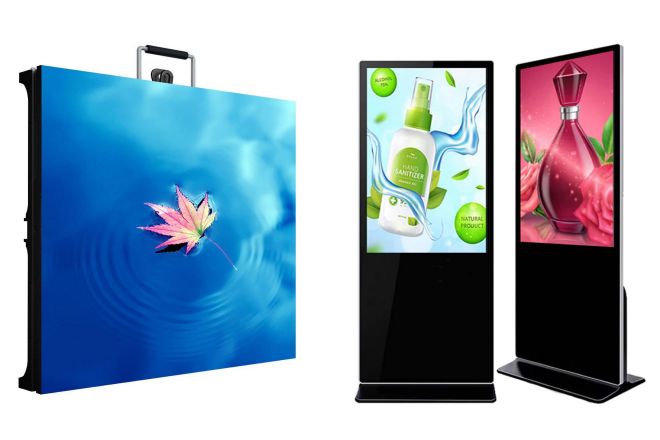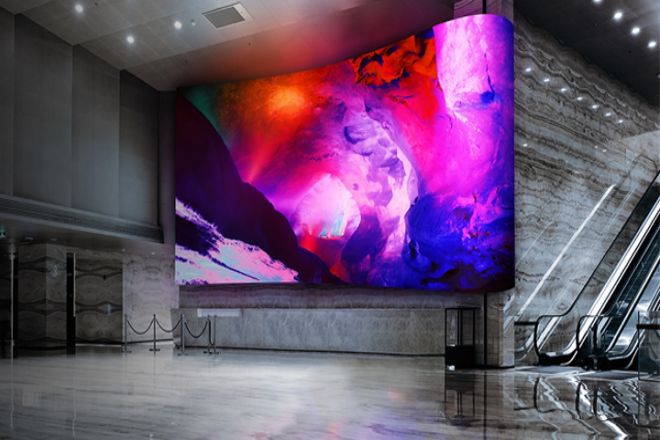Introduction

Today, with the rapid development of science and technology, display technology is an essential window for human-computer interaction, and its development and progress directly affect our daily lives and work.
Afficheurs LED and LCDs, two common display technologies, are widely used in various fields. Each of them has unique advantages and characteristics, but there are also certain differences.
In order to better understand these two display technologies and choose suitable application scenarios, this article will delve into the main differences between LED displays and LCDs.
1. Advantages and disadvantages of LED display
LED display, also known as light-emitting diode display, is a device that displays information by controlling the display mode of semiconductor light-emitting diodes. It consists of an LED dot matrix and displays text, images, videos, and other information by controlling the on and off states of different LED lights.
1). Avantage:
- Vivid picture presentation:
Have you ever seen a billboard outdoors in strong sunlight, but the writing is still clearly visible? This is probably where the magic of LED displays lies. Its high brightness maintains a clear display even under direct sunlight.
High contrast means that the difference between the background and the image is obvious; just like in a black-and-white movie, the picture is black and white and very clear.
- Économie d'énergie et protection de l'environnement :
LED displays use relatively less energy, which means they are more energy efficient than other types of displays. At the same time, it does not contain harmful substances and is fully in line with the green environmental protection concept of modern society.
- Long lifespan:
Imagine buying a TV that can continue to work for tens of thousands of hours without damage. Doesn’t it feel very worth it? The LED display screen is like this. It has a very long service life and can continue to provide you with high-quality display services.
- Wide viewing angle:
Whether you are standing at the front, side, or back, you can clearly see the content on the LED display. This wide viewing angle range allows it to provide the best viewing experience for viewers on various occasions, such as sports games, concerts, etc.
- Highly customizable:
The LED display can be customized according to your needs; no matter what size, resolution, or shape you need, it can meet you. This flexibility makes it a great advantage in a variety of applications.
- Strong adaptability:
Whether it is high or low temperature, humid or dry, the LED display can work normally. This strong adaptability allows it to perform well in various harsh environments.

2). Shortcoming
- Higher cost:
Although LED display screen has many advantages, its price is relatively high. This is because its production process and materials used are relatively special.
- Weight and volume:
LED displays are usually heavier and larger in size, which may cause some difficulties in transportation and installation.
- Maintenance cost:
Although the LED display screen has a long service life, it still requires regular maintenance and upkeep during use to ensure its normal operation. This may add some additional costs.
2. Advantages and Disadvantages of LCD
LCD is the full name of Liquid Crystal Display, that is, liquid crystal display. This kind of display screen is mainly composed of two parallel glass plates filled with liquid crystal material in the middle. When an electric current is passed through these liquid crystal materials, the liquid crystal molecules rearrange, creating an image.
1). Avantage:
- Économie d'énergie et protection de l'environnement :
Compared with some other display technologies, LCD’s power consumption is much lower. This means that devices using LCD consume less power when running for a long time, which not only helps save energy but also reduces the burden on the environment.
- Healthy and harmless:
Electromagnetic radiation is an invisible energy emitted by many electronic devices. Prolonged exposure to equipment with high electromagnetic radiation may have negative effects on human health, such as headaches, eye fatigue, etc. LCD is a display technology that does not produce electromagnetic radiation.
This means that whether you are working or playing, facing the LCD screen for a long time will not pose a threat to your health. LCD provides you with a safe and comfortable environment.
- Rich colors:
Color is a very important part of display technology. LCD is able to present a very wide range of vivid colors through its unique display principle.
This means that whether you are watching movies, playing games, or working, LCD can bring you a real and vivid visual experience. You can clearly see every detail and every color as if you were in a real scene.
- Wide Viewing Angle:
Have you ever had the experience of watching TV or a computer with friends, but when you turn slightly away from the front, the color and brightness of the screen change?
This is usually due to the smaller viewing angles of other display technologies. The LCD is different; it has a wide viewing angle. This means that no matter where you sit, you can clearly see the content on the screen, and the color and brightness remain the same. This provides great convenience for multiple people to watch at the same time.

2). Défaut:
- Color accuracy issues:
In some cases, the LCD may not represent certain colors completely accurately, especially when displaying dark colors or blacks. This may affect the realism of the image or video.
- High energy consumption during the manufacturing process:
Although LCD consumes less power when operating, it can consume a lot of energy during the manufacturing process. This means that although we can save energy when using LCD equipment, its production process may have a certain impact on the environment. Therefore, when choosing a display technology, we also need to consider its energy consumption and environmental impact throughout its life cycle.
- Viewing angle dependence:
Although LCDs have a wide viewing angle, color, and brightness may still change when the viewing angle is too extreme. This may impact the viewing experience for users sitting at the edge of the screen. While this change is not noticeable in most cases, it may be uncomfortable for some users who are very sensitive to color and brightness.
3. what is the difference between LED display and LCD?

1). Drive mode:
An LCD (liquid crystal display panel) is like a child that needs to be “fed” regularly. It relies on an external power source to provide energy to make the screen light up and display images. In this way, just like we need to eat to obtain energy every day, the LCD screen also needs power to drive its work.
The LED display screen is more like an adult with self-sufficient energy. It does not require an external power supply because its voltage is usually within 3 volts, which is enough to generate the required energy by itself. Just like a fitness guru, the LED display can generate its own light and does not require an external energy supply.
2). Working principle:
LCDs (Liquid Crystal Display Panels) work very similarly to water flow. When electric current passes through electrodes on the glass substrate, like water flowing through a water pipe, these currents flow toward the liquid crystal molecules.
Liquid crystal molecules change under the action of electric current, thereby changing the propagation direction of light and producing various colors and images.
The LED display is more like a small light bulb. It directly converts electrical energy into light energy and then sends out picture signals through pixels. This conversion process is very fast and efficient, allowing the LED display to present bright and clear images.
3). Life cycle:
The life of LCD panels is usually very long and can theoretically reach more than 50,000 hours. This means that if you buy an LCD device, it has the potential to last you for many years without noticeable deterioration or damage.
However, the life of LED displays is relatively short, usually around 20,000 hours. But it’s worth noting that this is just an estimate of the average lifespan, and the actual lifespan may vary based on a variety of factors.
4). Energy consumption:
In terms of energy consumption, LED displays have significant advantages over LCDs. According to data, LED displays save up to 48% more power than commonly used CCFL LCD screens! This means that using LED displays can not only save users’ electricity bills but also help reduce energy waste and reduce environmental burdens.
5). Color gamut:
The color gamut can be thought of as a large stage of color, which determines the range of colors that a monitor can present. The LED display has a wider color gamut, which is like a larger stage and can display more colors.
According to the standards set by NTSC (National Television Standards Committee), the color gamut that a color monitor can display is NTSC100%. The color gamut coverage of ordinary LCD displays can usually reach about 78%, but LED backlight technology can easily exceed this standard and present users with more colorful pictures.
6). Contrast:
The LED backlight system is like a smart director, which can further improve the uniformity of light emission, and with the multi-point control supported by LED, it can greatly improve the display contrast. This makes the LED display more vivid and contrasty when displaying black and white.
Now, LED displays can reach a contrast ratio of 1 million:1, far exceeding the contrast level of LCD. This high contrast makes the picture more vivid and details more prominent.
7). Brightness:
The brightness of the LED display is very high, just like a big bright light. Its brightness is usually between 3500-5500 cd/m2, which means that the LED display can still maintain a clearly visible picture even outdoors or in a very bright indoor environment.
In comparison, the brightness of LCD is relatively low, usually between 250-1500 cd/m2. This makes the LED display have better visual effects and higher readability when used outdoors.
8). Image quality:
If you view the screen at a close distance, such as within 1 meter, the picture quality of the LCD screen will usually be clearer and more detailed. This is because the LCD’s pixels are arranged more closely, making the picture more detailed.
The graininess of LED display lamp beads will be more obvious, especially when viewed at close range, and its clarity may be slightly inferior to LCD.
However, when you stand at a normal viewing distance, such as 2 meters away, the difference in image quality between the two is no longer so obvious. This is because the human eye has limited resolution and cannot distinguish such small differences in details.
Therefore, in daily use, whether it is an LCD or LED display, its image quality performance is quite excellent.
4. Is it suitable to use LED display or LCD?

When choosing between LCD and LED displays, here are some more specific considerations:
1). Scenes to be used:
Outdoor or strong light environment: If you plan to use the display outdoors or indoors in a place with very bright light (such as shopping malls, exhibition halls, etc.), an LED display would be a better choice. Its high brightness and high contrast ensure a clear picture even under strong light.
Indoor or low-light environments: For indoor use, especially in low-light environments such as home theaters, offices, etc., LCD displays are usually adequate.
2). Viewing distance and size:
Close viewing: If you plan to view the screen up close, such as with a computer or tablet, LCDs generally provide a more detailed image because their pixels are usually smaller and more closely packed.
Long-distance viewing: For large-screen TVs or public displays, the LED display screen allows for a clear picture even when viewed from a distance due to its high brightness and high contrast.
3). Budget:
Cost considerations: LED displays are generally more expensive than LCD displays, especially in large-screen applications. Therefore, budget can be an important deciding factor.
Long-term cost: While the initial purchase cost of an LED display may be higher, the long-term cost is likely to be lower considering its generally longer lifespan and lower energy consumption.
4). Image quality and color:
Color gamut: LED displays usually have a wider color gamut and can display richer, more vivid colors. This is especially important for professional applications such as image and video editing.
Contrast and Brightness: As mentioned earlier, LED displays have advantages in contrast and brightness, which makes them better at displaying dark details and highlights.
5). Other factors:
Energy efficiency: LCD displays are generally more energy efficient than LED displays, which is especially important when used for extended periods of time.
Environmental considerations: LED displays are often viewed as a more environmentally friendly option due to their long lifespan and low energy consumption.
Conclusion
When summarizing the choice between LCD and LED displays, we can say that each display technology has its unique advantages and application scenarios. As long as you know their differences and understand their advantages and disadvantages, you can make a better choice.
If you are interested in an LED display, veuillez nous contacter !
